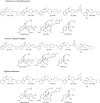Activities of mixed NOP and mu-opioid receptor ligands
- PMID: 18059322
- PMCID: PMC2241792
- DOI: 10.1038/sj.bjp.0707598
Activities of mixed NOP and mu-opioid receptor ligands
Abstract
Background and purpose: Compounds that activate both NOP and mu-opioid receptors might be useful as analgesics and drug abuse medications. Studies were carried out to better understand the biological activity of such compounds.
Experimental approach: Binding affinities were determined on membranes from cells transfected with NOP and opioid receptors. Functional activity was determined by [(35)S]GTPgammaS binding on cell membranes and using the mouse vas deferens preparation in vitro and the tail flick antinociception assay in vivo.
Key results: Compounds ranged in affinity from SR14150, 20-fold selective for NOP receptors, to buprenorphine, 50-fold selective for mu-opioid receptors. In the [(35)S]GTPgammaS assay, SR compounds ranged from full agonist to antagonist at NOP receptors and most were partial agonists at mu-opioid receptors. Buprenorphine was a low efficacy partial agonist at mu-opioid receptors, but did not stimulate [(35)S]GTPgammaS binding through NOP. In the mouse vas deferens, each compound, except for SR16430, inhibited electrically induced contractions. In each case, except for N/OFQ itself, the inhibition was due to mu-opioid receptor activation, as determined by equivalent results in NOP receptor knockout tissues. SR14150 showed antinociceptive activity in the tail flick test, which was reversed by the opioid antagonist naloxone.
Conclusions and implications: Compounds that bind to both mu-opioid and NOP receptors have antinociceptive activity but the relative contribution of each receptor is unclear. These experiments help characterize compounds that bind to both receptors, to better understand the mechanism behind their biological activities, and identify new pharmacological tools to characterize NOP and opioid receptors.
Figures






Similar articles
-
Nociceptin/orphanin FQ receptor activation attenuates antinociception induced by mixed nociceptin/orphanin FQ/mu-opioid receptor agonists.J Pharmacol Exp Ther. 2009 Dec;331(3):946-53. doi: 10.1124/jpet.109.156711. Epub 2009 Aug 27. J Pharmacol Exp Ther. 2009. PMID: 19713488 Free PMC article.
-
[Dmt1]N/OFQ(1-13)-NH2: a potent nociceptin/orphanin FQ and opioid receptor universal agonist.Br J Pharmacol. 2013 Jan;168(1):151-62. doi: 10.1111/j.1476-5381.2012.02115.x. Br J Pharmacol. 2013. PMID: 22827708 Free PMC article.
-
Comparative biochemical and pharmacological characterization of a novel, NOP receptor selective hexapeptide, Ac-RYYRIR-ol.Brain Res Bull. 2010 Mar 16;81(4-5):477-83. doi: 10.1016/j.brainresbull.2009.09.013. Epub 2009 Oct 2. Brain Res Bull. 2010. PMID: 19800951
-
The nociceptin/orphanin FQ receptor (NOP) as a target for drug abuse medications.Curr Top Med Chem. 2011;11(9):1151-6. doi: 10.2174/156802611795371341. Curr Top Med Chem. 2011. PMID: 21050175 Free PMC article. Review.
-
The therapeutic potential of nociceptin/orphanin FQ receptor agonists as analgesics without abuse liability.ACS Chem Neurosci. 2013 Feb 20;4(2):214-24. doi: 10.1021/cn300124f. Epub 2012 Nov 6. ACS Chem Neurosci. 2013. PMID: 23421672 Free PMC article. Review.
Cited by
-
Retrodialysis of N/OFQ into the nucleus accumbens shell blocks cocaine-induced increases in extracellular dopamine and locomotor activity.Eur J Pharmacol. 2013 Jan 15;699(1-3):200-6. doi: 10.1016/j.ejphar.2012.11.050. Epub 2012 Dec 5. Eur J Pharmacol. 2013. PMID: 23219985 Free PMC article.
-
Synthesis, Biological Evaluation, and SAR Studies of 14β-phenylacetyl Substituted 17-cyclopropylmethyl-7, 8-dihydronoroxymorphinones Derivatives: Ligands With Mixed NOP and Opioid Receptor Profile.Front Psychiatry. 2018 Sep 19;9:430. doi: 10.3389/fpsyt.2018.00430. eCollection 2018. Front Psychiatry. 2018. PMID: 30283364 Free PMC article.
-
Effects of NOP-Related Ligands in Nonhuman Primates.Handb Exp Pharmacol. 2019;254:323-343. doi: 10.1007/164_2019_211. Handb Exp Pharmacol. 2019. PMID: 30879202 Free PMC article.
-
Central N/OFQ-NOP Receptor System in Pain Modulation.Adv Pharmacol. 2016;75:217-43. doi: 10.1016/bs.apha.2015.10.001. Epub 2015 Dec 17. Adv Pharmacol. 2016. PMID: 26920014 Free PMC article. Review.
-
A bifunctional nociceptin and mu opioid receptor agonist is analgesic without opioid side effects in nonhuman primates.Sci Transl Med. 2018 Aug 29;10(456):eaar3483. doi: 10.1126/scitranslmed.aar3483. Sci Transl Med. 2018. PMID: 30158150 Free PMC article.
References
-
- Adapa ID, Toll L. Relationship between binding affinity and functional activity of nociceptin/orphanin FQ. Neuropeptides. 1997;31:403–408. - PubMed
-
- Berzetei-Gurske IP, Schwartz RW, Toll L. Determination of activity for nociceptin in the mouse vas deferens. Eur J Pharmacol. 1996;302:R1–R2. - PubMed
-
- Bloms-Funke P, Gillen C, Schuettler AJ, Wnendt S. Agonistic effects of the opioid buprenorphine on the nociceptin/OFQ receptor. Peptides. 2000;21:1141–1146. - PubMed
-
- Bunzow JR, Saez C, Mortrud M, Bouvier C, Williams JT, Low M, et al. Molecular cloning and tissue distribution of a putative member of the rat opioid receptor gene family that is not a mu, delta or kappa opioid receptor type. FEBS Lett. 1994;347:284–288. - PubMed
-
- Burnside JL, Rodriguez L, Toll L. Species differences in the efficacy of compounds at the nociceptin receptor (ORL1) Peptides. 2000;21:1147–1154. - PubMed
Publication types
MeSH terms
Substances
Grants and funding
LinkOut - more resources
Full Text Sources
Other Literature Sources
Medical
Research Materials

